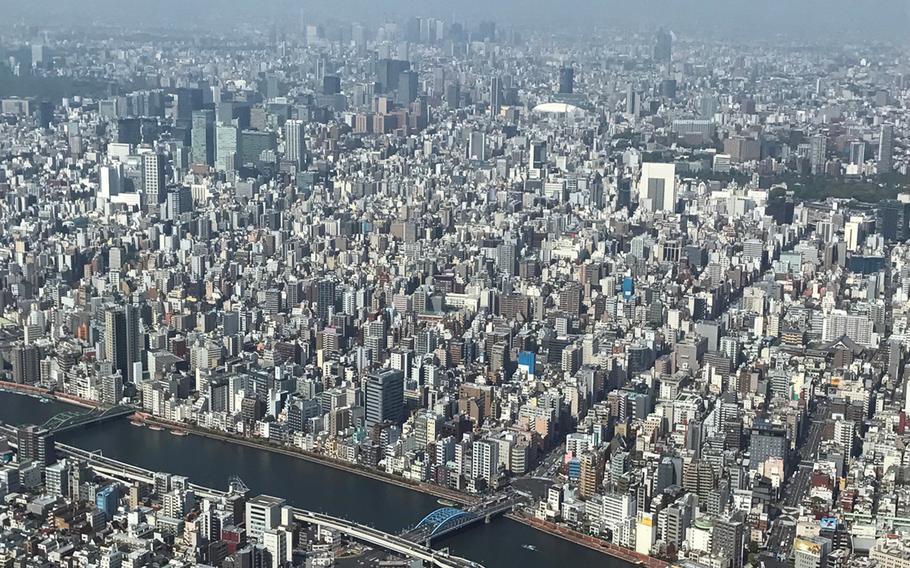
On a clear day, visitors to Tokyo Skytree can even get a glimpse of Mt. Fuji. (Hana Kusumoto/Stars and Stripes)
Want to see how big Tokyo really is? Go up Tokyo Skytree, the tallest public observation tower in the city where nothing blocks the view of the sprawling metropolis below. Six years since its opening, Skytree remains one of the most popular tourist attractions in Tokyo, with long lines of visitors waiting to take in the view from the tower’s observation floors on weekends.
The incredible view isn’t all that Skytree offers tourists and visitors. There’s an aquarium, shopping mall, and even a planetarium to visit — making Tokyo Skytree a perfect addition to any excursion in the city.
Tokyo Skytree is in the East Tokyo neighborhood of Oshiage, a short walk across the Sumida River from Asakusa. Standing at a whopping 2,080 feet, Skytree dominates the Tokyo skyline. In fact, when it opened in 2012, the structure officially became the tallest tower in the world. (Skytree is also the world’s second-tallest free-standing structure, a little more than 700 feet shorter than Dubai’s Burj Khalifa.) On a clear day, visitors to Skytree can even get a glimpse of Mount Fuji.
Skytree was built as a functional replacement for the iconic Tokyo Tower, which had been used to send television and radio signals in the city since 1958. Tokyo Tower is 1,092 feet high — which meant the taller high-rise buildings that sprung up across central Tokyo during the latter half of the 20th century began to affect the tower’s broadcasting signals.
Visitors to Skytree are allowed access to two observatory decks, both of which are accessed via elevators. The lower observatory, called the Tembo Deck, is located almost 1,150 feet above ground. For an extra fee, visitors can advance to the Tembo Galleria on Floor 445, which features a large spiral walkway of floor-to-ceiling glass windows. Here, the Sorakara Point is the highest viewpoint in Tokyo at 1,480 feet. The view from the upper observatory isn’t too different from the lower floors — but the glass walkway makes you feel as if you are walking on air.
On the way back down the tower, take a snapshot on Floor 340, where a glass floor allows visitors to peer down through the structure of the tower. Cafes, restaurants and souvenir shops are located in the upper section of the tower, on Floor 345 and Floor 350.
After taking in the views of the city, head to the ground floors for a visit to the Sumida Aquarium. Most of the aquarium is dark, and relies on ambient lights to illuminate the tanks and create a mood that highlights the mystery of the sea. The aquarium is known for its penguin exhibit, said to feature one of the largest indoor pool tanks in Japan. The tank gives visitors an up-close look of the dozens of penguins inhabiting the tank as they swim by.
Also located on the lower floors of the building is Tokyo Solamachi, a shopping mall featuring more than 300 shops and restaurants. The mall’s 4th floor is dedicated entirely to shops selling Japanese souvenirs for tourists, including Japanese cooking knives, chopsticks, washi paper and fans. At Ameshin, shoppers can watch as workers make traditional candy from scratch, pulling and bending the sugar syrup into intricate shapes such as goldfish and rabbits.
Tokyo Solamachi offers plenty of entertainment for children, including indoor playgrounds and Kodomo No Yu, an onsen-themed amusement park featuring Japanese festival games and a large ball pit.
TOKYO SKYTREEDIRECTIONS: Tokyo Skytree is accessible via the Tobu Skytree Line at Tokyo Skytree Station (1-minute walk), or via the Tokyo Metro Hanzomon Line and Toei Asakusa Line at Oshiage Station (2-minute walk).
TIMES: The Tokyo Skytree observation decks are open daily 8 a.m. to 10 p.m., with last entry at 9 p.m. Schedule might change during the New Year’s holidays. The Sumida Aquarium is open daily 9 a.m. to 9 p.m., including holidays. The Tokyo Solamachi mall is also open daily, including holidays, 10 a.m. to 9 p.m.
COSTS: To reach the lower Tembo Deck at Tokyo Skytree, same-day tickets cost 2,060 yen — about $18.40 — for adults, 1,749 yen for teenagers, 930 yen for elementary school students and 620 yen for preschoolers. An additional fee to reach the higher Tembo Galleria is required, and costs 1,030 yen for adults, 820 yen for teens, 520 yen for elementary school students and 310 yen for preschoolers. Children 4 and younger are free. Foreign tourists and foreign nationals residing in Japan may purchase a special Fast Skytree Ticket that allows visitors to skip the lines. The tickets — which start at 3,000 yen for ages 12 and older and 1,500 yen ages 4 to 11 — require showing a foreign passport to purchase.
FOOD: A wide variety of restaurants and cafes are located both at Skytree and in Tokyo Solamachi Mall. At the mall, restaurants are on floors at 6, 7, 30 and 31 and open 11 a.m. to 11 p.m.
INFORMATION:tokyo-skytree.jp/en